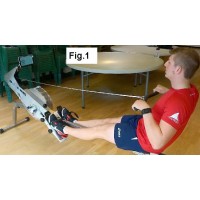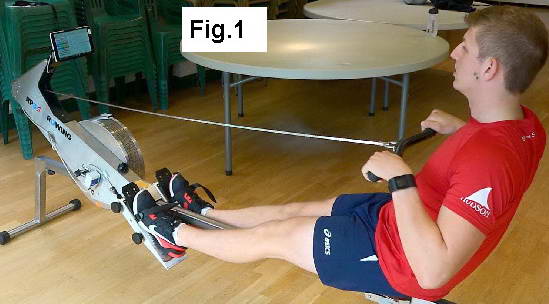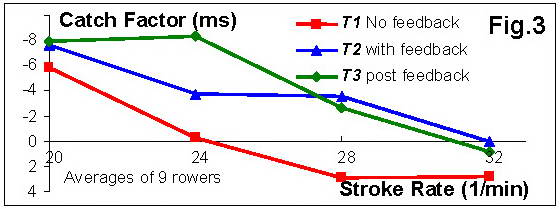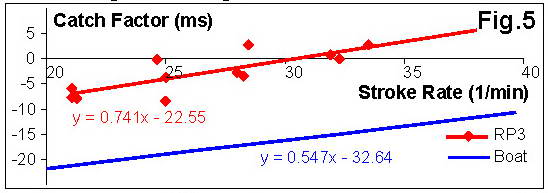Effect of using Catch Training System

An experimental evaluation of the effect of using the BioRow Catch Training System (CTS, see RBN 2016/05) was recently conducted on a group of nine junior scullers. The testing protocol was set as 2 minutes of continuous rowing on the RP3 machine equipped with CTS (Fig.1), with increasing steps of the stroke rate every 30s: 20, 24, 28 and 32 str/min.
 This protocol was repeated three times with an
unlimited rest period:
This protocol was repeated three times with an
unlimited rest period:
T1 - Without
feedback from CTS (the screen was covered) to check initial habits;
T2 - With immediate
feedback on a tablet PC;
T3 - Without feedback from CTS again, to check persistence of technical changes.

The feedback screen (Fig.2) displayed velocities
of the handle and seat and two main factors:
CATCH FACTOR (CF)
ŌĆō is the time difference between the stop moments (changing direction) of the handle
and the seat at the catch. The target CF (the green zone) was set from -15
to -35 ms, which means the seat should change direction earlier than the
handle. More significant negative numbers (blue zone from -75 to -35ms) mean
the stretcher is pushed too early, which leads to a waste of leg work. Higher
positive numbers (red zone from -15 to +25ms) mean the seat is engaged too
late, which leads to insufficient acceleration of the rowerŌĆÖs mass and a less
dynamic drive.
ROWING STYLE FACTOR (RSF) ŌĆō is the ratio of travel distances of the seat to the handle during the first 20% of the drive (about 30cm from the catch). The target RSF (the green zone) was set from 85% to 100%. Numbers higher than 100% (blue zone 100-130%) indicate ŌĆśslide shootingŌĆÖ ŌĆōwhere the seat travels further than the handle. Lower numbers (red zone from 55% to 85%) mean ŌĆ£grabbingŌĆØ arms and shoulders, or opening the trunk up too early, which is also ineffective.
The results of the experiment have shown a significant positive effect of rowing with immediate feedback and most importantly a high persistence of technical changes. An average CF of 9 rowers and all four stroke rates (Fig.3) has decreased from -0.1ms at T1 down to -3.7ms during T2 and to -4.5ms in T3, so it became closer to the target zone.

The results of the experiment have shown a significant positive effect of rowing with immediate feedback and most importantly a high persistence of technical changes. An average CF of 9 rowers and all four stroke rates (Fig.3) has decreased from -0.1ms at T1 down to -3.7ms during T2 and to -4.5ms in T3, so it became closer to the target zone.

It was found that CF significantly depends on the stroke rate, but RSF does not. Fig.5 shows this dependence of CF in this experiment (red line) and an average trend of on-water measurements (blue, n=20742), which had a similar slope, but quite a different offset. From rate 20 to 40spm, CF on RP3 erg increases from -8ms up to +7ms (the seat engaged later at higher rates), and on water it increases from -21ms up to -11ms. These findings will be used to set a more adequate CF target zone -20 to 0ms on the RP3.

Seven out of these nine rowers were measured on the water in two quads a week before this experiment, so their data was compared at 32 spm (Tabl.1). A good in-group correlation was found and the above difference in CF was confirmed, but RSF was very similar in the boat and the RP3 in the initial trial.

Conclusion: The Catch Training System could be effectively used to make technical improvements.
The recorded effect was significant and persistent.
┬®2016 Dr. Valery Kleshnev www.biorow.com



